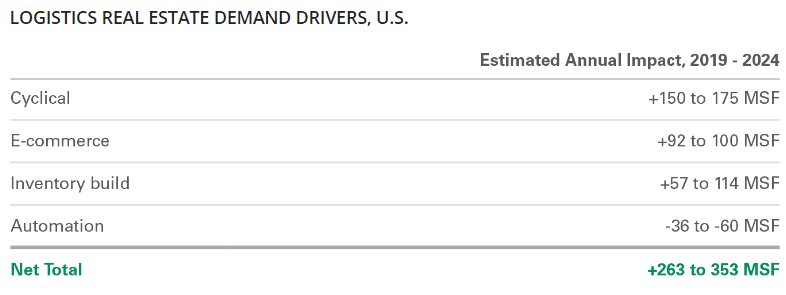There is a lot of interest and adoption of distribution center automation, and that’s good, because such automation can address two macro logistics issues: labor and space shortages.
So says a new report from distribution center developer Prologis, which notes that "The logistics real estate sector has been facing shortages on two key fronts: a shortage of skilled labor and of well-located logistics space."
Supply Chain Digest Says... |
|
|
Compounding those market challenges is a lack of last mile delivery capabilities. It was well publicized that in the just ended 2020 Holiday season, UPS, FedEx and DHL were refusing to accept parcels from some retailers and other shippers whose volumes exceeded their forecasts to the carriers.
Ecommerce of course is the key factor in the pressure on distribution labor and land shortages. An increasing number of shippers both in ecommerce and beyond are investing in DC automation to cope, Prologis says, adding that "those that do not act now are getting left behind."
The report also warns that ecommerce and other trends could lead to a critical shortage of logistics real estate. It predicts that new supply could fall short of demand by 50-140 million square feet (MSF) per year over the next five years.
Interestingly, it actually estimates the annual impact on US warehouse space demand from 2019 to 2024 from four factors – three of which are increasing demand, and one which (automation) is subtracting from needed DC space, as shown in the graphic below.
For example, Prologis says changes in inventory strategies coming out of the pandemic from just-in-time to just-in-case supply chains could drive US inventories up by 5-10% or more. On the other hand, more space-efficient automation is expected to decrease DC space demand from 36-60 MSF annually.
"Cyclical" refers to demand increases associated with general economic growth each year.
Netting just those factors out results 263 to 353 MSF of additional annual demand over the period.

Source: Prologis
Prologis notes that warehouse vacancy rates remain historically low, while speculative construction starts fell in both the second and third quarters of 2020, though that perhaps is a temporary effect of the virus pandemic.
The space shortages are especially seen in locations close to the end consumer, where barriers to supply are highest and labor is tight - and where space-intensive efulfillment volumes are greatest.
(See More Below)
|
CATEGORY SPONSOR: SOFTEON |
|
|
| |
|
|
The report notes that investments in DC automation are still driven primarily interest order lead times and improving accuracy to offer higher service levels and minimize reverse logistics costs rather than on increasing storage density.
Prologis breaks down DC automation into two main categories: fixed and mobile/semi-mobile technologies.
It says full fixed automation systems (e.g., AS/RS) can yield significant space efficiencies, yet barriers to implementation are high – notably costs, as well as the level of process change. Depending on the type of fixed automation, space efficiencies can range from zero to more than 50%. The gains in space efficiency can come from more cubic space being used for storage and/or conveyance, and/or from aisle space being significantly reduced.
On the other hand, mobile and semi-mobile automation can drive productivity gains but generally yields very modest space savings, ranging from zero to 10%.
Perhaps most interestingly, Prologis says that automation increases the revenue generation potential of logistics space – something more shippers might want to consider in addition to labor gains from DC automation.
The Prologis researchers modeled two separate scenarios in terms of future DC automation adoption in the US. Even under the more rapid adoption model and thus greater reduction in demand for space, the report says, logistics real estate demand is likely to exceed supply substantially, leading to the up to 140 million MSF of shortage per year over the next five years cited above.
And that means rates are likely to keep heading up over the period, while availability continues to fall.
Whar are your thoughts on more focus on the space benefits of DC automation? Let us know your thoughts at the Feedback section below.
|